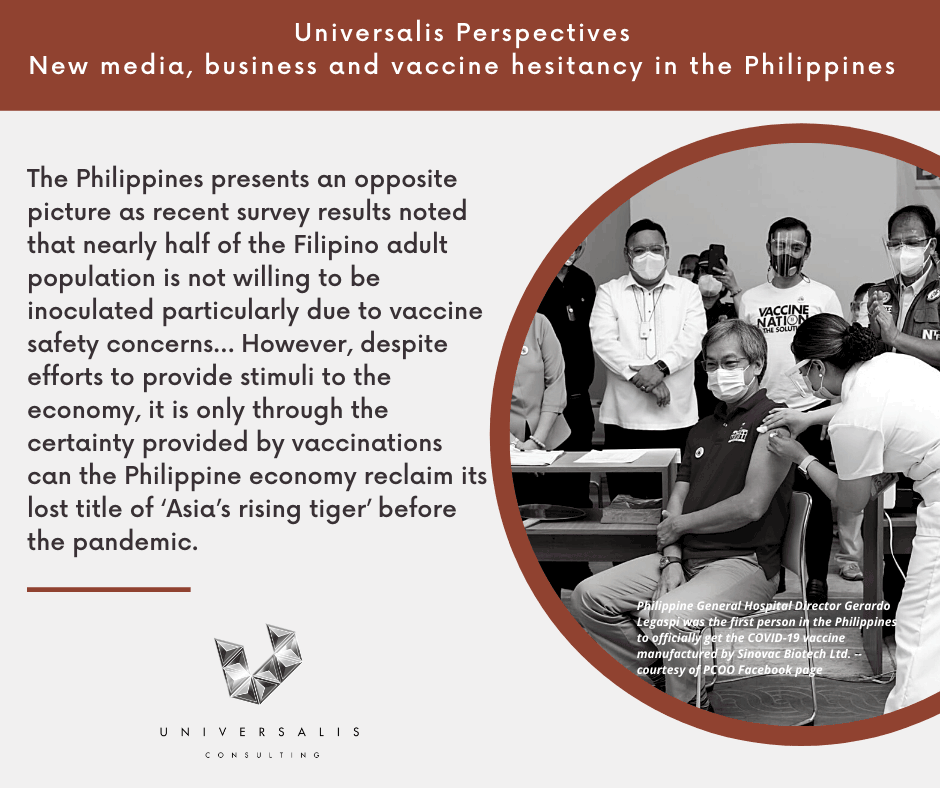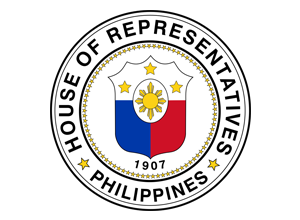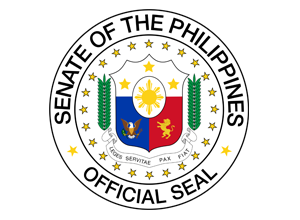Universalis Perspectives: New media, business and vaccine hesitancy in the Philippines

With the arrival of vaccine candidates coming from the United States, Europe and China authorized for emergency use, a spark of hope has finally emerged in a world continuously battling against the pandemic for almost a year. In fact, the Philippines already received its share of doses of Sinovac and AstraZeneca vaccines in the past wo weeks via the COVAX initiative. However, while other countries rejoice and express their optimism concerning the procurement and rollout of vaccines in their respective territories, the Philippines presents an opposite picture as recent survey results noted that nearly half of the Filipino adult population is not willing to be inoculated particularly due to vaccine safety concerns.
The current vaccine hesitancy among Filipinos is not without precedent. In a 2019 study, vaccine confidence among Filipinos has significantly dwindled from 2015 to 2018 due to the Dengvaxia controversy. Comparing vaccine-related attitudes among Filipinos from 2015 to 2018, the table below shows around 60% drop in terms of optimism towards vaccine confidence, vaccine safety, and vaccine efficacy.
| Indicators: | 2015 | 2018 |
| Vaccine confidence | 93% | 32% |
| Safety of vaccines | 82% | 21% |
| Efficacy of vaccines | 82% | 22% |
Larson, H., Hartigan-Go, K., & de Figuereido, A. (2019) Vaccine confidence plummets in the Philippines following dengue vaccine scare: why it matters to pandemic preparedness. Human Vaccines and Immunotherapeutics 15:3: 625-627.
The impact of the 2018 Dengvaxia controversy continues to linger. While a November 2020 SWS survey results discovered that more than half of Filipinos (66%) expressed willingness to take a COVID-19 vaccine, recent events and issues concerning the integrity of the government’s choice of vaccines primarily coming from China affected these earlier recorded attitudes. On 5 January 2021, the OCTA Research Group released an updated survey results that only 1 out 4 residents (25%) of Metro Manila are willing to take the vaccine. Two days after, a succeeding Pulse Asia Survey study using a nationwide sample supplemented the earlier findings of OCTA Research Group by revealing that only 32% of their 2,400 respondent sample expressed willingness to undergo inoculation. In addition, comparing the socio-economic profile of the respondent of both recent surveys, it is important to note that both OCTA and Pulse Asia surveys reveals that persons who are willing to be vaccinated are coming from classes A, B and C (29% and 33%, respectively) while those who refuse to be vaccinated are primarily concentrated in Class E (31% and 56%, respectively).
What can we do about the increasing rate of vaccine hesitancy in the country? Conventionally, addressing the issue of vaccine hesitancy has been always delegated as one of the responsibilities of the healthcare sector. However, with approximately one-year of exposure in the frontlines, the Philippine healthcare sector is already exhausted in its battle treating infected patients since the first quarter of 2020. Mired with limited funding, resources, and institutional controversies, solving vaccine hesitancy nationwide should not be the sole responsibility of the health sector. The time is ripe to spearhead a synchronized multi-sectoral and multi-institutional strategy to convince Filipinos about the safety and positive implications of being vaccinated. By surveying societal players that have been consistently active since the start of the pandemic, this article will specifically discuss the potential contributions the new media and business sector can offer to fight vaccine hesitancy and misinformation.
While the media has always been a reliable partner for the dissemination of health literacy including the benefits of vaccines, the space has already been captured by rampant disinformation and conspiracy theories about vaccine safety and efficiency. With traditional media outlets becoming less relevant as consumers showing preference to spend more time with social media, recent conversations discussed how to reclaim the social media space to provide truthful and accurate information concerning health interventions. Two specific strategies are notable and can be applied in the Philippine context, namely, the employment of new media strategies and adoption of anti-vaxxer clickbait mechanisms.
In a 2015 study about the effectiveness media interventions, among the new media strategies that contribute to the fight against vaccine hesitancy trend are the following: text messaging (37%), specialized software handled by medical workers (21%), smart-phone applications (5%), YouTube (5%), Facebook (5%), websites (5%), and e-mail communications (5%). While social media and Internet platforms have been already utilized to disseminate information about vaccines, the high share of text messaging in the success to curb vaccine hesitancy presents compatibility with the Philippine scenario since most Filipinos own a mobile phone. Using a sample of 1,969 Filipino respondents, results of a 2018 Pew Research Center survey indicated that only 73% of Filipino population are mobile phone users, and 66% of them are using phones incapable of connecting to the Internet.
On the other hand, adoption of anti-vaxxer strategies also presents a good opportunity to disseminate factual information about the vaccines. Most studies present in the scholarly literature argue that modern-day audience is no longer keen to read informative paraphernalia that sounds like a research report due to technical jargon and information such as the presence of numerical data, percentages, and statistical figures. A 2013 study proposed the use of narratives, anecdotes and story-telling to capture the interest of the targeted audience. The same study also raised the possibility of grooming “vaccine ambassadors” which is related to the proposal of a recent 2020 study that specifically outlined the probability of success by tapping celebrities. In addition, since this article advocates the use of new media strategies, a 2017 study on the digital network of pro-vaccine content that communication strategies should utilize click-baiting strategies among websites to catch the attention of vaccine-hesitant individuals.
Meanwhile, governments should also tap the assistance of the private business sector to address the vaccine hesitancy problem. In a World Economic Forum report, businesses play a critical role in ending the pandemic because of the crucial part employers can perform to influence the vaccine attitudes of their employees. Citing results from the Edelman Report, employees tend to rely more on their employers about COVID-19 related information. On the other hand, GAVI – the vaccine alliance responsible for the COVAVAX facility aiming to provide affordable vaccine supply to poor countries – also noted the important role of the business sector particularly in terms of public-private partnerships since they provide financial, technical and logistical assistance in the delivery of vaccines to the poverty-stricken and marginalized areas around the globe.
With the media considered as the Philippines’ fifth estate and with the successes of the Philippine government in harnessing public-private partnerships’ capability to deliver socio-economic outcomes, now is the time to rediscover new avenues and strategies to assist the Filipino nation’s recovery from the impacts of the current pandemic. While the initial response of the government to the pandemic was described by former NEDA Chief Ernesto Pernia as “out of sync”, the problem posed by heightened vaccine hesitancy among Filipinos also presents opportunities for the government to develop a comprehensive national plan involving LGUs, traditional and new media outlets, and private businesses.
While the Executive Department has been known to partner with celebrities to promote their specific projects, it is also time to tap the potential impact of Filipino social media influencers in their platforms especially in Facebook and Instagram. A good model to emulate is the video content produced by an American social media personality cum medical practitioner popularly known as Doctor Mike where he shared his vaccination experience and answered questions about vaccine safety and issues surrounding its early rollout and distribution.
On the other hand, since businesses serve as potential instruments to produce social trust among its employees to fight vaccine hesitancy, it is proposed that the government – both national and local – must accommodate and appreciate the private sector’s capabilities such as but not limited to promoting information dissemination about the necessity of getting vaccinated, fostering transparency about the vaccination effects to the human body, and developing databases in tracking whether employees already received or completed the required dosages. In addition, if mass vaccination is already feasible in the country, the Philippine government should also explore the legal dimension about the plausibility and feasibility of providing incentives to firms that will be successful in convincing their employees to get inoculations. Moreover, it is also recommended that business clubs and chambers based in the Philippines should also steer their member-companies to a commitment of bringing their respective employees to avail immunization in a specific timeframe.
Indeed, despite efforts to provide stimuli to the economy, it is only through the certainty provided by vaccinations can the Philippine economy reclaim its lost title of “Asia’s rising tiger” before the pandemic.


